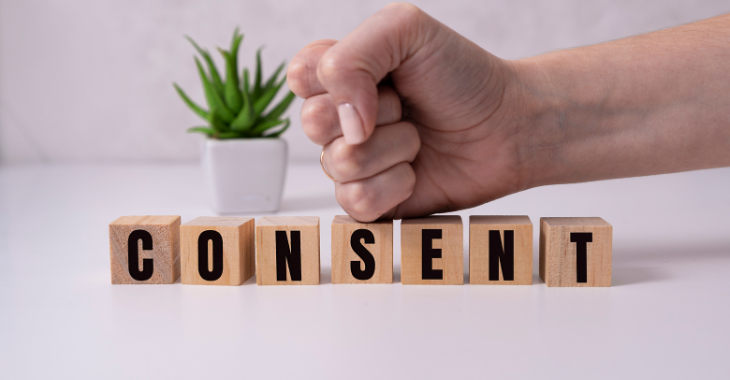Putting an end to the “gray zone” of consent

Consent is a concept that raises many questions during our training sessions, as it seems so vague to our participants. We often talk about how difficult it is to explain its contours, and how it's mostly a matter of perception and feeling. How do we know if there is consent? Aren't there any "gray areas"?
Consent is a decisive condition in the qualification of many forms of violence, so it's essential to share a common conviction about what it is or isn't. But consent doesn't always mean consent. However, consent does not always mean desire: we may consent for other reasons. It therefore seems essential to strengthen our ability to express our consent or non-consent, and to hear what others have to say.
Consent as a condition for qualifying violence
In France, consent, or rather the absence of consent, is one of the conditions required to qualify numerous forms of violence (sexism, sexual or sexist harassment, sexual assault, moral harassment, etc.). The law uses the terms "imposing" (Penal Code) or "subjecting" (Labor Code) to condemn acts imposed against a person's consent.
It is generally up to the victim to prove that he or she did not consent. In the absence of evidence of non-consent, the law tends to presume that it exists. This is notably the case in the definition of sexual assault and rape (articles 222-22 and 2222-23 of the Penal Code); if "threat, violence, constraint or surprise" is proven, then consent has not been given. Consent is therefore defined by what it is not.
By contrast, in other countries, consent is characterized by an explicit "yes", meaning that "anything other than yes is no". In this way, the definition of rape is more exhaustive. Spain, Sweden and Japan are among the countries that have adopted this new definition over the past five years. Their laws are based on the 2011 Istanbul Convention against violence against women (article 36 of which defines rape as "non-consensual vaginal, anal or oral penetration of a sexual nature of the body of another person with any part of the body or with an object"), which is also what the European Commission would like to see adopted. For the time being, France is maintaining its position on the matter, in the face of demands from certain associations and experts[1].
Consent as an expression of desire, but not only
During our training sessions, we often discuss the expression of consent, particularly in the professional environment, where we know that power is at stake. This raises a number of questions:
Why do we say "yes"? We may say "yes" not because we want to, but for other reasons such as to please, to make ourselves look good, with the implicit expectation of receiving something in return, or because we're persuaded, or even, at the extreme limit, we give in under pressure or in the hope that the person will stop there. This is where consent begins to be disrespected.
What do we say "yes" to? Knowing what you're saying "yes" to seems simple in practice: yes to a mission, yes to a work task, yes to help, yes to share a moment, yes to commit to... But you still need to be sure of how far you're saying "yes", for how long, for what results or for what satisfaction. This is where you need to be explicit and precise in your requests.
Why is it hard to say "no"? We may not want to offend, create embarrassment or disappoint, because we think the other person expects it of us, because we think we have no choice, or because it may somehow backfire on us, or we may even be flabbergasted or feel insecure. This is where we need to give the person the time and space to say "yes" or "no" in a sincere and informed way.
Consent must be as explicit as possible to avoid misunderstandings, embarrassment and even violence.
Practicing consent properly
In training, we present the various characteristics of consent [2], which must be :
- Enthusiastic, meaning that if there's the slightest doubt, I can ask the person if they agree. The question can be asked at any stage.
- Free and informed: giving in is not consent, and if the person doesn't say "yes", I don't insist.
- Reversible: just because I say yes once, doesn't mean I say yes for all the other times. Temporary: I can change my mind at any time.
- Specific: consent is not extensible: I can consent to one thing but not to others.
So what are the best practices for consent? Here are a few basic principles:
- Proactively seek consent: "do you want to? do you mind? would you like to? are you okay with...?".
- Don't assume or anticipate what the other person thinks or wants.
- Regularly question the relationship to find out if everything's going well, provoking dialogue on habits, customs, humor, etc.
- Respect "no" as a legitimate limit set by the other person to ensure his or her well-being, or even to make him or her feel protected
- Consider that asking the question shows above all that you are interested in the other person's well-being.
- Wanting the other person to feel secure, confident, oneself
- Avoid emphasizing disappointment or frustration in the face of a "no".
By ensuring consent, we show above all that we care about the other person, that we care for him or her, creating mutual trust, a relationship based on respect and benevolence where "no" is possible.
In our professional and personal lives, we don't always consent willingly, simply because in reality we have commitments, responsibilities or accept compromises. But in certain intimate, risky or constrained situations, it's essential to raise the question of consent, motivation and expression. In short: LET'S TALK - you can never do too much.
References
[1] Les Pièges du consentement, Catherine Le Magueresse, 2021, Editions iXe, 228p



